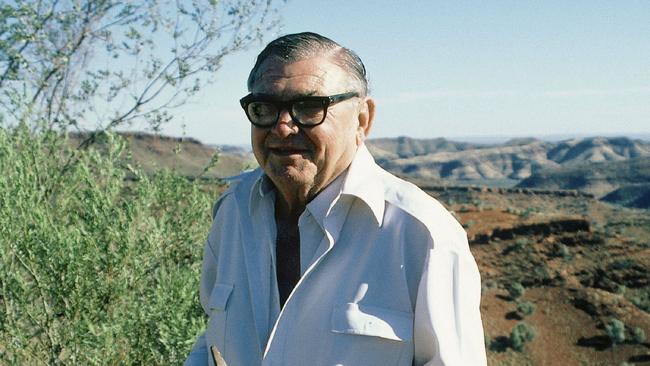Rinehart legal battle: Lang Hancock tried to avert future lawfare between children
Lang Hancock orchestrated a division of the Pilbara iron ore assets held by him and Peter Wright in an ultimately futile attempt to avoid future legal battles between their children.

Iron ore pioneer Lang Hancock orchestrated a division of the Pilbara iron ore assets held by him and his business partner Peter Wright in an ultimately futile attempt to avoid future legal battles between their children, Western Australia’s Supreme Court has heard.
Noel Hutley SC, the barrister leading the defence of Gina Rinehart’s Hancock Prospecting, or HPPL, against a potentially multi-billion-dollar claim from Wright Prospecting, or WPPL, on Tuesday read out correspondence from Hancock to support his case that Wright did not have any right to the lucrative iron ore assets now held by HPPL that are at the centre of the courtroom battle.
The documents included a memo sent by Hancock to his then-business partner in which he described the need for a comprehensive separation of their assets “so as not to leave grey areas for our respective heirs to argue about”.
Some 30 barristers – including representatives of Mrs Rinehart, her children, Wright’s daughter Angela Bennett and two of his grandchildren – will continue to pack out the Supreme Court’s largest courtroom for the next several months as they fight over whether WPPL is entitled to millions of dollars of royalties from HPPL’’s Hope Downs iron ore joint venture and a stake in the big East Angelas iron ore deposits.
Mr Hutley described letters showing how Hancock was “emphatically opposed to anything less than a complete split” of the assets held by HPPL and WPPL.
The letters showed how Hancock was growing increasingly frustrated by clauses requiring the two partners to keep the other apprised of their efforts and offer one another the opportunity to participate in new ventures.
“The present agreement between us is rapidly getting to the stage which as I foresaw has so many strings tied on me and it is paralysing my efforts to get going and the whole thing could collapse,” he wrote in one memo read out by Mr Hutley.
That frustration led to a 1987 agreement that Mr Hutley said outlined a clear division of the interests of the two groups. He described a record from that era in which Wright’s son Michael appeared to agree to a full separation of the interests of the companies.
“If you want a division, we will co-operate with you … and we have accepted that. We are not going to fight it,” Michael Wright told Hancock.
Mr Hutley also addressed the letter raised early in the trial by Wright Prospecting’s legal team, which showed Hancock informing Mrs Rinehart of Wright Prospecting’s interests in the assets at the centre of the trial.
While Wright argued the letter was of significance, Mr Hutley said it was “of the most peripheral relevance” to the case: “If anything, far from this document being adverse to our case,it supports our case to the extent it has any relevance, and we embrace it.”
Mr Hutley urged judge Jennifer Smith not to be “distracted or beguiled” by the arguments put forward by Wright Prospecting.
The 1987 agreement set out how Wright would give up its stake in Hope Downs as part of a carve-up of the Pilbara assets held by the iron ore pioneers.
He argued that the documents produced by Wright earlier in the trial should not distract from the weight of the 1987 contract.
“Orthodox construction starts and usually ends with words of the contract. That, with respect, is not how WPPL has approached the task,” he said.
He said he would produce documents that showed that the Wright family believed it had secured the superior deal from the carve-up of the assets.
“The Wrights thought they got the better of it in a goodly way,” he said.

